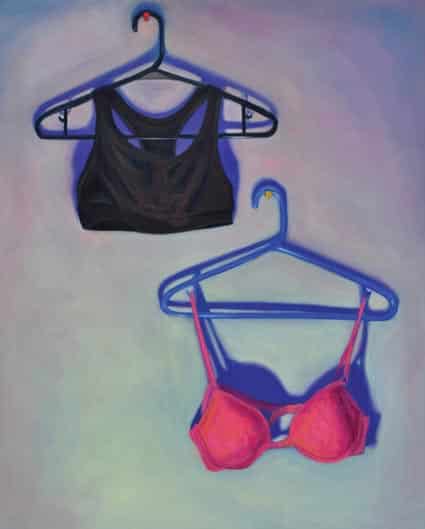by Laura Pappano
As a blogger and reader of women’s sports blogs, I’ve learned that one subject reliably spurs sharp (even bitter) debate: Female athletes’ bodies and how they use them. Whether the occasion is the Sports Illustrated swimsuit issue, bare-all ESPN magazine spreads or even NCAA softballers planning time for hair and make-up to play in televised championships, it hits a well-worn nerve.

The arguments line up as neatly as opposing soccer teams before the starting whistle. Some point out that women athletes with fabulous bodies and appealing looks should take advantage. If sex appeal broadens name recognition and brings attention, why not call in a little cheesecake to build the fan base? But others argue that pursuit of sexiness undercuts the status of women as serious athletes and, by extension, women’s sports as legitimate, compelling athletic events. You don’t look to lingerie football for great play. If tuning into women’s sports is about watching not for skills but for skin, isn’t that a problem?
The stark division, in other words, comes down to this: When female athletes lean on sex appeal, they either 1) are doing what they must to compete in a noisy and unfair world, or 2) succumbing to a sexist value system that pushes women’s sports to the margins and would rather treat women as sex objects than acknowledge their talent. Neither of these ideas is new. In fact, their constancy has gotten annoying. Can’t we move the conversation forward?
We are stuck, I think, for three reasons: 1) Despite Title IX and “progress,” we are still unsure what the job description “female athlete” entails; 2) Sports and sex appeal are linked, but that link is more fraught for women; 3) Women’s bodies are still not, culturally speaking, their own.
Let’s take these in order.
Thanks to TV shows like Mad Men, we now laugh at outrageous treatment of women in the workplace in the 1960s and see how far we’ve come. But as cleanly as we understand the status of “secretary” in that era, we lack a similar context for “female athlete.” We are still figuring out her responsibilities. Must she be a Disneylike role model for little girls? May she be a ruthless (even mean) competitor? Must she be “nice” and “friendly,” signing autographs for hours?
Playing Like Ladies
Look at “bad” behavior – say, the famous ponytail pull or Serena’s cussing at an umpire at the U.S. Open – to be reminded of the narrow range of acceptable comportment for female athletes. The reason treatment of women in Mad Men is so funny is because women are now the majority of college graduates and earning more advanced degrees than men. Title IX helped women move from the sidelines onto the field, but advancement is slow. In a growing number of households, women are the big earners. In sports, they are still fighting for fans, pay and media coverage. When a female athlete plays up to male heterosexual desires, it looks like an inside job to thwart equity.
Yet – to get to point number two – on some level all commercial sport is about sex appeal. NFL quarterbacks are the sexy face of the franchise in a league marketing to women (pink gear aside) as well as to men. Sex appeal is all over men’s sports, from the NBA to NASCAR, MLS and tennis. Guys take off their shirts before crowds (and not just because it’s too warm for comfort). For female athletes, the matter is more charged. How to differentiate between sex appeal that is part of the package and sex appeal that is the package? Sadly, lots of ink has been spilled debating whether Danica Patrick is earning attention because she’s a promising driver or because she’s “sexy,” a word she reportedly doesn’t like being called.
At the root of the conflict is that organized sports are gendered as “masculine,” invented to prepare boys for “manhood” as women trained to rule the home. Victorians believed that the future of society depended on men and women occupying “separate spheres.” Football with its helmets and taking of territory taught boys lessons their fathers learned on the Civil War battlefield. So even though women took to basketball almost as soon as it was invented in 1891, the first games drew outrage: Aggressive female play was “mannish” and might drive players to take on male characteristics. (Solution: restrictive girl’s rules.)

By the 1950s female basketball players and track athletes wore make-up and short-shorts to “prove” their femininity (and heterosexuality). Fear of developing “ugly muscles” kept many girls from sports altogether. During the Cold War, the U.S. was trounced by the Soviet Union in Olympic Medal counts – with women to blame. At the 1960 Olympics, Soviet women earned 28 medals to American women’s 12. A 1963 Sports Illustrated article featured an attractive Russian female athlete and asked, “Why Can’t We Beat This Girl?” The article said the reason American girls can’t run faster is that “most won’t even try.”
Women Deserve Bodily Control
We may not consider this history today, but its influence lingers. For female athletes, the cultural context in which they play has changed some, but not enough, since the 1960s. Female beauty is today less Twiggy and more Serena, but we still feel conflict around physical performance and physical attractiveness. Patriots QB Tom Brady can frolic with farm animals, yet no one doubts his intentions when he steps up to throw. But U.S. World Cup team player Brandi Chastain’s act of celebratory zest still gets read as a striptease. When female athletes appear in the Sports Illustrated swimsuit issue, do we see the beauty of the female athlete’s body – or another victim of the bottomless appetite for fresh, sexy images? How many who ogle the female athletes in Sports Illustrated have seen them play with clothes on? Is it different when a household-name athlete like Serena is the subject? Is she sharing with the world just how beautiful and powerful her body is? Or is she just playing nasty? We never know intention — just as we don’t understand how sexy images of women athletes are received.
Part of the matter – to address the third point – is that women’s bodies are not really their own. One might read the decision to market one’s sex appeal, particularly in the context of the revived political debate over contraception, as the quest for a woman to control the use of her own body. Consider that for generations women’s reproductive role has been subject to regulation by governments, courts and sports organizations under the guise of “protecting” women to insure the future population. It kept menstruating women in Victorian times from law school (blood needed for study would go to the brain, leaving a barren womb), and, later, girls from Little League (they would get hurt) until 1973, just to name two. It has taken years and loads of energy to challenge these views.
| Seeking real equity means learning to appreciate female athletes’ performances |
Females want to be in charge of their bodies, whether it’s deciding to wrestle on the middle school team or to become a parent. If access to birth control has been critical to women’s rising rates of education, salaries and career advancement, isn’t the ability to command a magazine cover just another vehicle for increasing economic power?
The “right” to market one’s sex appeal may not be of equal weight to the right to reproductive freedom, but we should recognize that athletes who pose nude or employ sex appeal are not necessarily subverting female power or the goal of advancing gender equity in sport. In the past, I have expressed disappointment to see sultriness where I’d hoped for competitive sass. There is still plenty of sexiness that is mostly about titillation (read: NASCAR’s Cope twins). But much of the debate is a distraction to the fundamental challenge of getting to a more fair place. We spar now because women’s sports still feels fragile and temporary (will WPS — Women’s Professional Soccer — really come back?) Certainly, we will always reserve admiration for athletes – male or female – who are strong role models and good people. But seeking real equity for female athletes means learning to appreciate female athletes’ performances on their own. We may be desperate for role models for daughters and want proper, PR-friendly sunny-dispositioned stars. But equality means not making girl-next-door comportment a condition of our support.
Laura Pappano writes for the NY Times Education Life and the Harvard Education Letter, is a writer-in-residence at the Wellesley Centers for Women, author of “Inside School Turnarounds” (Harvard Ed 2010) and coauthor of “Playing with the Boys” (Oxford 2007) She is founder and editor of FairGameNews.com.
Also see Winning the Sports Beat: Female Writers Need Wide Angle Lens by Marie Hardin in this edition of On The Issues Magazine.
See Women On High: The Price of Passion at the Roof of the World by Jennifer Jordan in this edition of On The Issues Magazine.
Read the Cafe for new and updated stories.
